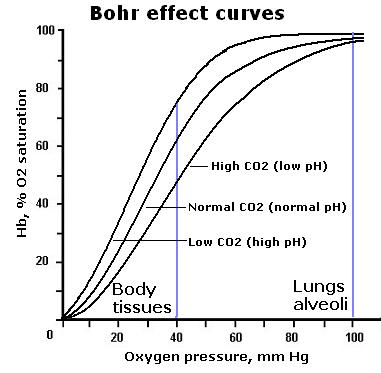
Oxygen dissociation curve
- The effect of carbon dioxide and acidity favor the formation of Oxyhaemoglobin at low concentration of CO2 and H+ ion and causes the dissociation of Oxyhaemoglobin releasing O2 at high concentration of CO2 and H+ ion.
- This shift in curve of oxyhaemoglobin due to concentration of carbondioxide at given partial pressure of oxygen, is known as Bohr effect.
- The amount of Oxygen take up by Haemoglobin at particular time to from Oxyhaemoglobin is called percentage saturation.
- The graph of percentage of O2 saturation of haemoglobin plotted against partial pressure of Oxygen (PO2) is called Oxygen dissociation curve.
- The Oxygen dissociation curve is S-shaped (sigmoidal shape).
- The curve indicates that haemoglobin has high affinity to Oxygen.
- In human arterial blood have PO2 of about 95-100 mmHg, at this level percentage of O2 saturation of Hb is about 97 %. This indicates the formation of Oxyhaemoglobin is favored.
- Similarly, the venous blood have PO2 of 40mmHg,at this level percentage of O2 saturation of Hb is about 70%.
Effect of Carbon-dioxide on Oxygen dissociation curve:
- The effect of CO2 on Oxygen dissociation curve is known as Bohr effect.
- It has been found that increase in concentration of CO2 decreases the amount of oxyhaemoglobin formation.
- according to Bohr effect, for any particular partial pressure of Oxygen, the affinity of Haemoglobin toward Oxygen decreases and favors dissociation of oxyhaemoglobin when the partial pressure of carbondioxide increases.
- It means, higher CO2 concentration causes the dissociation of HbO2 releasing free O2.
- Increase in PCO2 shifts the O2 dissociation curve downwards. Higher PCO2 lowers the affinity of haemoglobin for O2.

Fig. Oxygen dissociation curve of haemoglobin at different partial pressure of CO2
- Bohr effect is very important physiological phenomenon, because uptake of oxygen in lungs and its releases in the tissue is regulated by the concentration of CO2 and H+ ion as well as the partial pressure of O2. So, this phenomenon made possible the cellular transport and release of O2.
- PCO2 is lower in lungs than tissue, so Hb has higher affinity for O2, therefore it favors HbO2 formation and transport of O2 from lungs to tissue. similarly PCO2 is higher in tissue, so it favors dissociation of HbO2 releasing free O2 and transport of CO2 from tissue to lungs.
